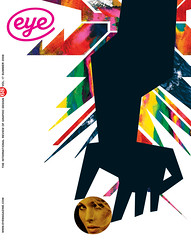Summer 2008
Filip Blazek
Who cares about graphic design history?
Filip Blazek was born in Prague and graduated in cultural studies (with a focus on society and graphic design) from Charles University, Prague, in 2002.
Q1. What do you think is meant by ‘the canon of graphic design history’? Do you buy design history publications?
A1. I often buy and read books on the history of graphic design, mostly about the early days of Czech typography. Now I am biased to Jan Tschichold, partly because of his relation to Czechs or Slavs in general, partly because I have just read Christopher Burke’s Active Literature: Jan Tschichold and New Typography. I enjoy finding traces of Tschichold’s paradigm in the work of Czech designers before the Second World War. However, it is quite likely I will have another hero next year…
Q2. Does design history have relevance to your practice?
A2. Sure, as a designer, I love to confront my work and relate it to well proven solutions of similar problems 200 or twenty years ago. I prefer to balance on the edge between tradition and innovation. I can’t imagine working without at least an elemental knowledge of graphic design history.
Q3. Where did you learn about design history?
A3. In the books and magazines I bought in foreign bookstores and internet shops. And when I want to know more about a particular person or a style, as an editor of Typo magazine, I try to find an expert to write about it for us.
Q4. Does history have any relevance to the new technology and techniques you’ve had to master in your work?
A4. History is of crucial relevance to me. I am deeply interested in type and font technology, and it is very appealing to keep track of contemporary type designers, how they interpret alphabets more than 500 years old and how they try to cope with brilliance of old masters.
Q5. If you were in charge of a design education programme, what aspects of design history would you teach to your students?
A5. I have been lecturing to students on a one-year basic course in Interactive Design at a private graphic design school for about seven years now. In my lessons on graphic design, I introduce the era between 1880 and today; my talks about type start with the invention of the letter press. I always document the importance of history for graphic design – my favourite examples are works of contemporary Iranian graphic designers, mainly my friend Reza Abedini. I am afraid the ties between history and graphic design are disappearing in our culture.
First published in Eye no. 68 vol. 17 2008
Eye is the world’s most beautiful and collectable graphic design journal, published quarterly for professional designers, students and anyone interested in critical, informed writing about graphic design and visual culture. It is available from all good design bookshops and online at the Eye shop, where you can buy subscriptions and single issues.

